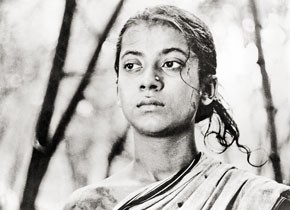Satyajit Ray: The First Decade
December 4, 2013 to January 8, 2014
Satyajit Ray (1921–92) was neither the first Indian filmmaker whose works were shown regularly at European festivals, nor was he the first to win an award there. And yet, it all seems to have started with him: his debut film, Pather Panchali (1955), was hailed as a revelation when it world-premiered at the Museum of Modern Art, during the exhibition Textile and Ornamental Arts of India. A year later, the sequel, Aparajito (1956) would receive the Golden Lion in Venice.
Ray, however, proved not to be a flash-in-the-pan: up until his death, his work was followed around the world, even if it wasn't fully appreciated in all of its complexity. His attempts to politicize his work in the early 1970s caused headaches for some, while others were unsure about his repeated forays into light entertainment. However, it is precisely this variety of cinematic subjects and idioms and his constant search for a contemporary stance that mark Ray's genius. This is already clearly apparent in the first – and very busy – decade of his career.
At the end of the 1990s, the Film Museum and the Viennale assembled the first comprehensive retrospective of Ray's works in Austria, although several early films were missing such as the comedy The Philosopher's Stone and his drama of redemption, The Expedition. The current exhibition presents Ray's complete early works, from his role as an assistant to Jean Renoir (The River) and the “Apu Trilogy” of the late 1950s to that perfect midpoint summation of his career, the diptych The Coward and the Holy Man (1965). Pars pro toto – and thanks to the magnificent restoration work of the Academy Film Archive after Ray’s death – the series thus invites viewers to study Ray’s cosmos in its full tonal, philosophical and narrative range.
Satyajit Ray was born into a Bengali family of intellectuals: his grandfather, Upendrakishore Raychaudhuri, was a well-known publisher, musician, author of children's books and pioneer of engraved printing; his father, the writer Sukumar Ray, was feared for his biting satire and loved for his nonsense rhymes. Satyajit Ray continued in the family tradition of Renaissance genius: he wrote a series of mysteries for children with his own illustrations that appeared in a magazine he also published, created several type fonts (including "Ray Bizarre"), proved to be a brilliant composer – and directed over thirty films.
He had studied painting, but the cinema held a stronger pull. In 1947, Ray and the critic Cidananda Dasgupta founded the Calcutta Film Society, the first Indian film club based on the British model. This enabled him to quickly study the Western European and Soviet cinemas. Like many of his generation, Ray was intensely attracted to neo-realism, but his encounter with Jean Renoir during the filming of The River (1951) proved equally important – both influences are apparent in Pather Panchali. The ideas in this first film transcend time and cultural differences and are in harmony with a certain humanist approach to filmmaking after the war that also included names such as Akira Kurosawa and Lester James Peries (in Sri Lanka) – two giants of cinema to whom Ray felt deeply connected. What is less obvious for western observers is the political dimension of his films: they are rooted in the specific tradition of an enlightened Bengali bourgeoisie and in the Nehruist approach to nation building.
Even more fascinating is the speed with which Ray was able to diversify his work, deliberately emphasizing these multiple facets through a series of episodic films – as witnessed by the epochal triptych Three Daughters (1961, based on the work of Rabindranath Tagore) and the "double film" The Coward and the Holy Man. With The Philosopher's Stone (1958), Ray proved early on that a certain playful mischievousness was as interesting to him as the epic realism of the “Apu Trilogy.” The same year saw the release of his masterpiece The Music Room (1958), which once again struck new tones with its darkly morbid melancholy, only to be followed by the heated agitation of The Goddess (1960). Monihara, part 2 of Three Daughters, finally demonstrated Ray's virtuosity in the horror genre as well.
With Kanchenjungha (1962), color came into play – and it was also the first of Ray’s unforgiving examinations of the bourgeoisie and their rituals. This new direction in his work is beautifully documented in the masterpieces that followed: The Big City (1963) and The Lonely Wife (1964). As far as the milieu and Ray's attitude towards his characters are concerned, there are certain parallels between The Music Room and Kanchenjungha, but each film would always become its own new adventure, the start of something new. We must not forget: Satyajit Ray nearly single-handedly and in multiple forms created a Bengali-Indian art cinema along "western" lines. A cinema which to this day guides every Indian filmmaker who tries to wrest something different from the local entertainment industry – and to strike out once again in an entirely new direction.
The retrospective is organized in close partnership with the Academy of Motion Picture Arts & Sciences.


